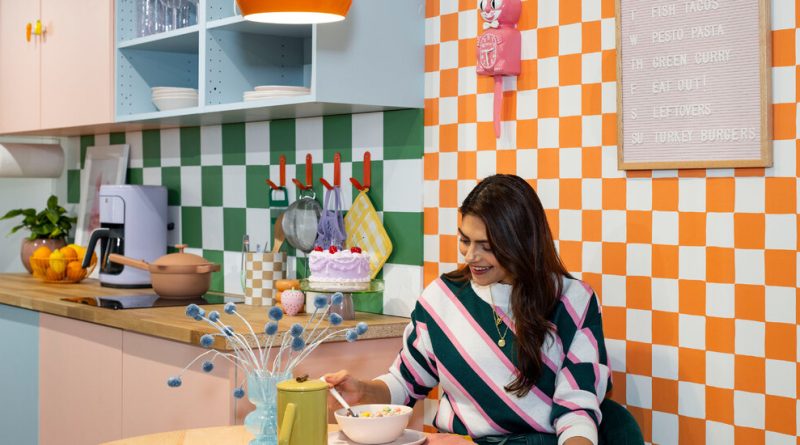What Makes a Tiny Home Cool? Apartment Therapy’s Latest Pop-Up Has Ideas
[ad_1]
“Likely, when we close our eyes and think of a small space, it’s white walls, no lighting and bad storage,” said Nate Berkus.
Mr. Berkus, the celebrity interior designer, was standing in a bright, cabinet-outfitted bathroom that he designed for Apartment Therapy’s “Small/Cool NYC,” a pop-up exhibition in Sunset Park, Brooklyn. The event, which is running on consecutive weekends this month and will conclude on Sunday, Oct. 29, is halfway between a showhouse and a showroom.
More than a dozen 10-by-12-foot room schemes — imagined by creators as fresh as Maitri Mody, a fashion influencer who posts on Instagram under the name Honey I Dressed the Pug, and as seasoned as the talk-show host and domestic strategist Drew Barrymore — offer tips for loosening up tight quarters. Visitors can steal ideas like Ms. Mody’s choice of fruit-and-vegetable-shaped hardware on sherbet-colored kitchen cabinets or they can shop the settings using QR codes.
“I want every room to be a solution, as well as cool looking,” said Maxwell Ryan, who founded Apartment Therapy with his brother, Oliver Ryan, as a design blog for urbanites in 2004 and has overseen its development into a media company with multiple branches. (Dorm Therapy, a design platform executed by a network of college students, is the latest.)
“Small/Cool” began in the mid-aughts, when the Ryan brothers, inspired by the College Humor website’s N.C.A.A.-like tournament, with brackets, to find “the hottest college girl,” asked readers to post photos of their cool, compact homes for others to vote on.
“Looking back, that was not tasteful,” he said.
The contest eventually ran out of steam and was retired several years later, but came “roaring back” during the pandemic, Mr. Ryan said. As he revived it, his team proposed a noncompetitive adjunct that would have products and solutions visitors could interact with and buy — something reminiscent of the time when department stores like Bloomingdale’s showed furniture in realistic, room-like settings.
After a couple of efforts that had a virtual dimension because of the pandemic, the pop-up, in-real-life version of “Small/Cool NYC” fully materialized last year in SoHo. The current edition is at Industry City, the retail and manufacturing complex in Brooklyn.
Each invited decorator was handed a theme.
Kim White, a New York designer, tackled her subject, “House of Hacks,” with a “Murphy desk” that unfolds from a wall and a terrazzo-patterned table that can be raised and lowered by remote control for dining or coffee drinking.
Carmen René Smith, a self-described maximalist designer and artist in Oakland, Calif., addressed her theme, “Parisian Pastiche,” with a stew of rococo, deco and surrealist ingredients and a fireplace filled with liquor bottles entwined with fairy lights.
“My brief was to be inspired by a major fashion house,” said DuVäl Reynolds, a designer in Fairfax, Va. He imagined a private saloon that would be appreciated by a heritage-respecting grandson of Ralph Lauren taking a serious detour from the family’s hunting lodge. This room, with its plaid walls, cowhide rug, midcentury-modern furniture and beaded black chandelier, is what Mr. Lauren might have designed if he were channeling the Playboy magazine founder Hugh Hefner with maybe a touch of Miss Kitty, the saloonkeeper from the long-running TV western “Gunsmoke.”
“Most people think a bar has to be this big, clunky thing with a ton of storage,” Mr. Reynolds said. But the only really identifying markers are a counter and stools, he added, and the counter can be a floating length of wood wrapped in contact paper that looks remarkably like stone and is supported by brackets from Home Depot. So mindful was he of his limited space that he used fake, hollowed-out books for stashing barware.
Hollie Velten-Lattrell, a designer in Maplewood, N.J., said her theme, “Hipstoric Nowstalgia,” jived perfectly with her studio’s emphasis on vintage finds that are revived through carpentry and new upholstery.
“I was trying to pack in experiences instead of stuff,” she said, pointing out that a common misperception of small rooms is that furniture needs to be arranged around the periphery. By creating a central conversation area dominated by a sofa, she produced little side nooks for enjoying music (“a listening booth”) and sipping cocktails (“a bistro”). The sofa’s ruffled topper has the dual benefit of disguising upholstery stains and hiding object overflow under its skirt.
Asked if much has changed in the design of small spaces since he founded Apartment Therapy almost two decades ago, Mr. Ryan said, “My gut instinct is no. Vendors change and styles change, but the solutions are somewhat evergreen.”
His goal for the platform was always to “speak to that first moment when you come to that first home,” he said, adding that he hopes to serve an audience of fledglings forever.
“Martha Stewart taught a whole generation how to set a table, make a bed, paint a wall for the first time,” he said. “It’s not so much that things change, but we keep doing it again and again.”
Living Small is a biweekly column exploring what it takes to lead a simpler, more sustainable or more compact life.
For weekly email updates on residential real estate news, sign up here.
